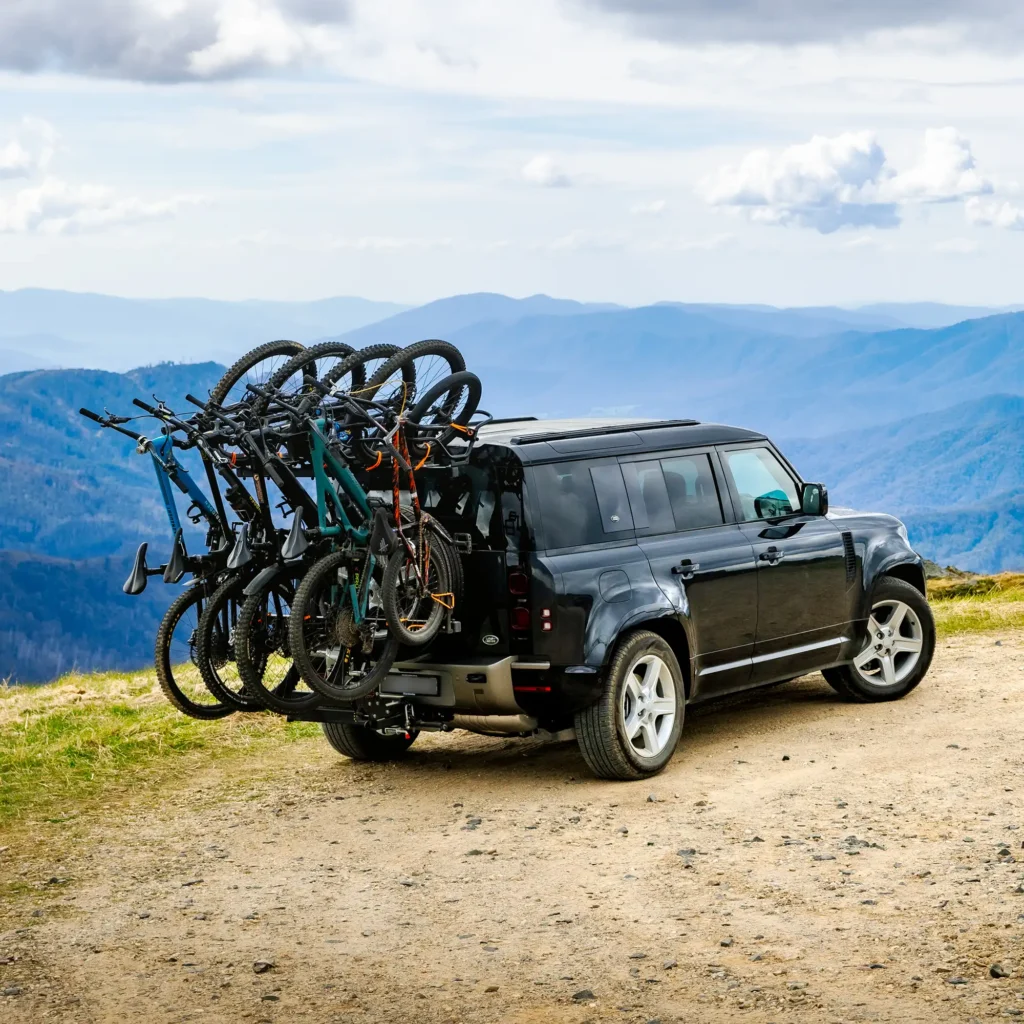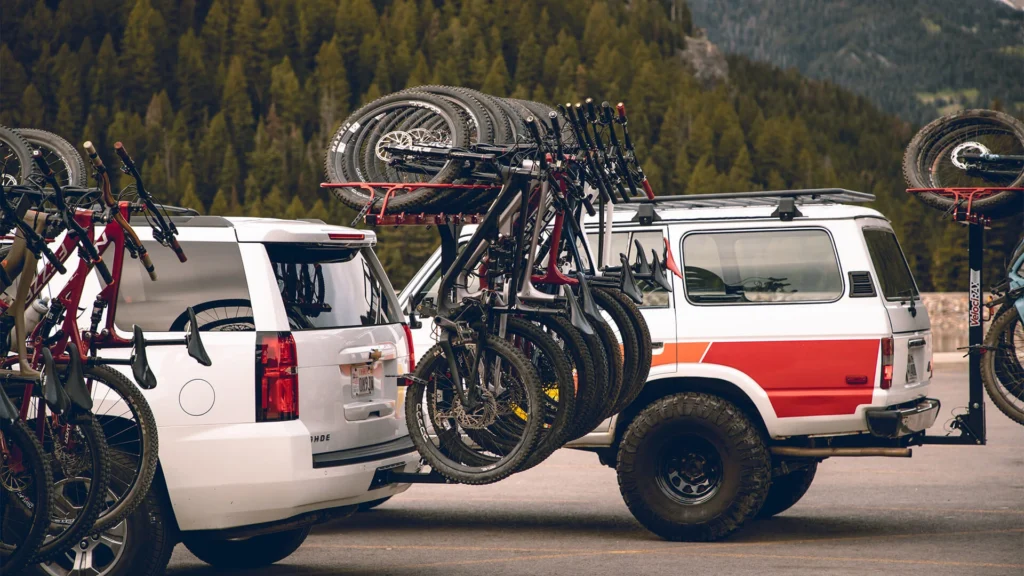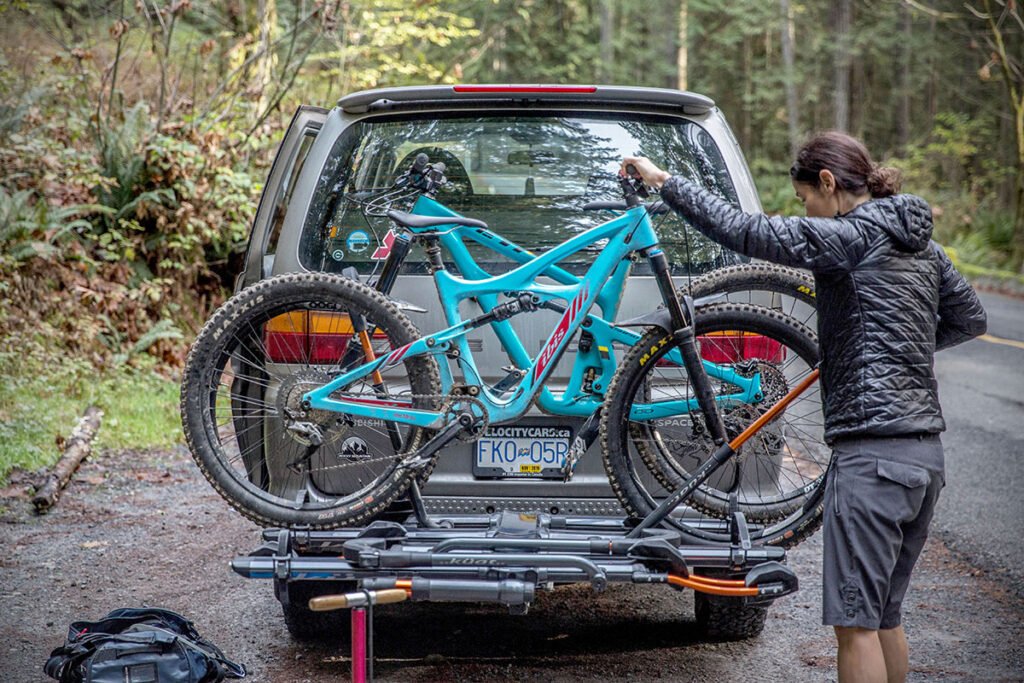When it comes to transporting your bike, having the right bicycle carrier rack can make all the difference. Whether you’re heading for a weekend getaway, a cycling race, or a mountain biking adventure, the right rack ensures your bike stays safe and secure. With so many options available on the market, choosing the right one can be overwhelming. This guide will help you navigate through the different types of bike racks and the key factors you need to consider when choosing one.

Types of Bicycle Carrier Racks
Understanding the different types of bike racks is essential when deciding which one works best for your needs. Below, we’ll explore the three main types: roof racks, hitch racks, and trunk racks. Each has its benefits and limitations, depending on your car, bike, and preferences.
1. Roof Racks
Roof racks are ideal for vehicles that are equipped with roof rails. These racks mount on the roof of the car, allowing you to transport bikes without taking up space in the trunk or rear of the vehicle. Roof racks are especially useful if you have limited trunk space or if you want to keep the back of your car clear for other gear.
Benefits of Roof Racks:
- No obstruction to the rear view: Since the bike is mounted on the roof, it doesn’t block the view of your rear window, making it easier to drive.
- Access to the trunk: You can still open your car’s trunk or hatchback while the bike is mounted.
- Multiple bike capacity: Roof racks are generally more versatile and can carry two or more bikes, depending on the system you choose.
Drawbacks:
- Higher loading height: Loading and unloading bikes from the roof can be physically challenging, especially if your vehicle is tall.
- Fuel consumption: Roof racks can increase wind resistance, which may slightly reduce your vehicle’s fuel efficiency.
2. Hitch Racks
Hitch racks are designed to be mounted on the back of your vehicle, where a hitch receiver is installed. These racks are straightforward to install, usually requiring little more than sliding them into the hitch receiver. Hitch racks are the most popular choice for cyclists who regularly transport bikes.
Benefits of Hitch Racks:
- Ease of loading: With hitch racks, loading bikes is much easier compared to roof racks, as the rack is positioned at a more comfortable height.
- Secure and stable: Once your bike is mounted on a hitch rack, it stays securely in place with minimal movement.
- Access to the rear: Many hitch racks are designed to tilt down, giving you access to the trunk or hatch of your vehicle, even with bikes mounted.
Drawbacks:
- Rear visibility obstruction: Depending on the design, a hitch rack may block your rear view, making it harder to see out of your rear window.
- Vehicle compatibility: Some vehicles may not be compatible with hitch racks, or you may need to install a hitch receiver if your car doesn’t have one.
3. Trunk Racks
Trunk racks are perhaps the most affordable option, and they’re ideal for people who only need to transport bikes occasionally. These racks mount to the trunk or hatch of the car using straps and can usually be installed and removed in minutes. Trunk racks are a great choice for those with smaller vehicles or who need a temporary solution.
Benefits of Trunk Racks:
- Cost-effective: Trunk racks are generally cheaper than roof and hitch racks.
- Compact and easy to store: These racks can be easily stored in your car when not in use, taking up little space.
- No need for a hitch: If your car doesn’t have a hitch receiver, a trunk rack is a good option.
Drawbacks:
- Less stability: Trunk racks tend to be less stable than roof or hitch racks, especially when carrying multiple bikes.
- Limited bike capacity: Most trunk racks can only carry one or two bikes, so they’re not ideal for larger groups or families.
- Access to the trunk: Trunk racks can block access to your car’s trunk, so you might need to remove the bikes before accessing the storage space.

Factors to Consider When Choosing a Bicycle Carrier Rack
Choosing a rack depends on more than just the type of bike rack—it’s about ensuring compatibility, convenience, and the security of your bike. Here are the top factors you should consider before making a purchase.
1. Vehicle Compatibility
Before purchasing a bike rack, it’s essential to check if your vehicle is compatible with the type of rack you plan to use. Not all racks fit all vehicles, so understanding the requirements of each type of rack is crucial. Roof racks require roof rails, hitch racks require a hitch receiver, and trunk racks need to be compatible with the shape and size of your vehicle’s trunk.
Some vehicles, like sedans or sports cars, might not have the necessary infrastructure for a hitch rack, while others may have factory-installed roof rails. Be sure to check your car’s specifications or consult with the manufacturer before making a purchase.
2. Bike Capacity
How many bikes do you need to transport? If you’re a solo rider or only occasionally transport one bike, a trunk rack or smaller hitch rack may be sufficient. However, if you plan to travel with multiple bikes—perhaps for a family road trip or a cycling event—look for racks that can accommodate two or more bikes.
Many roof and hitch racks come in different configurations, allowing you to add more bike mounts if needed. Keep in mind that the more bikes you carry, the heavier the rack will be, so always check the weight limit of both the rack and your vehicle.
3. Security Features
One of the most important considerations when transporting bikes is security. Many bike racks come with built-in security features, such as lockable straps or integrated cable locks, to prevent theft. While you may not always be able to keep an eye on your bike while traveling, having the right security measures will give you peace of mind.
Look for racks with features like:
- Locking mechanisms: Secure your bikes to the rack with locks to prevent theft.
- Anti-sway cradles: These hold your bikes firmly in place and reduce the risk of the bikes swaying or making contact with each other during transport.
4. Ease of Use
Loading and unloading your bike shouldn’t be a struggle. Ease of use is a critical factor when choosing a bike rack. Roof racks, while providing excellent bike stability, can be more challenging to load due to the height of the vehicle. Hitch racks, on the other hand, are usually lower to the ground and much easier to load. Trunk racks are lightweight and quick to install, but they require more effort to adjust to fit your car.
If you frequently load and unload your bike, prioritize racks that are easy to handle and designed with convenience in mind. Some racks feature tilting mechanisms or foldable arms, making them more user-friendly.
5. Durability and Weather Resistance
Your bike rack will be exposed to the elements, so durability is a key factor. Look for racks made of corrosion-resistant materials, such as powder-coated steel or aluminum, that can withstand rain, snow, saltwater, and UV exposure without deteriorating.
Consider how your bike rack will hold up over time. A high-quality rack should last for many years, even with frequent use in various weather conditions. Be sure to clean your rack regularly to remove dirt and grime, especially after long trips.

Conclusion
Selecting the right bicycle carrier rack is about finding a balance between convenience, security, and durability. Whether you choose a roof rack, hitch rack, or trunk rack, it’s important to consider your vehicle’s compatibility, the number of bikes you need to transport, and your personal preferences regarding ease of use and security.
By taking the time to assess your needs and understand the features of different bike racks, you’ll be well on your way to finding the perfect solution to transport your bike safely and efficiently. With the right bike rack, you’ll be ready to hit the road and enjoy your ride—wherever the journey takes you.
